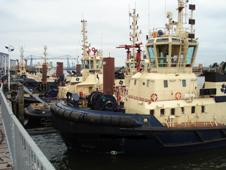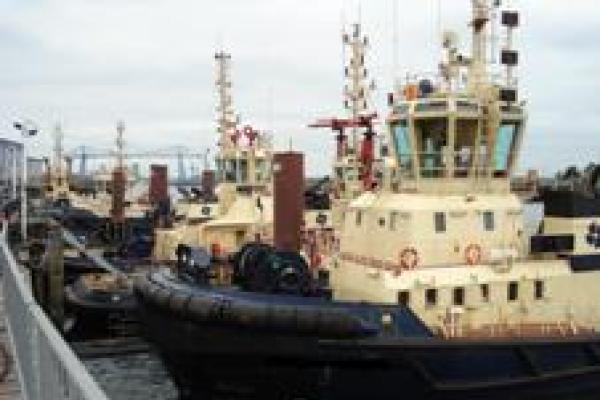
Steamship Mutual
Published: January 01, 2009

The Capsize and Sinking of the Tug "Flying Phantom"
On 19 December 2007 the 287 GRT harbour tug “Flying Phantom” was engaged in towing operations made fast to the bow of the 39,738 GRT bulk carrier “Red Jasmine” as she was inbound on the flood tide up the River Clyde to Glasgow. As the vessel approached the Dalmuir bend in darkness thick fog was encountered and the speed of the “Red Jasmine” was reduced, however, this led to difficulties in controlling the bulk carrier as she negotiated the bend necessitating the use of the tug ”Flying Phantom” on the bow to assist in pulling the bow to port and starboard so as to maintain the heading of the cargo vessel. Whilst engaged in pulling the ship’s bow to starboard the tug got into difficulty due to a combination of factors, including the fact that the personnel on the tug thought that they had grounded due to the close proximity of the river bank, and that the tug crew could not determine their position in relation to the “Red Jasmine” due to the thick fog obscuring the other vessel’s bow and her forward masthead light. Once the ”Flying Phantom” reported that she was aground the tug at the stern of the bulk carrier was instructed by the pilot to pull astern and the engine on the “Red Jasmine” was put full astern, however the ”Red Jasmine” moved past the tug sitting at the side on the river.
A combination of the attitude of the towline leading out to the tug’s port beam, a gog wire that was kept slack to allow free movement of the vessel whilst operating as a bow tug, and the fact that although the towline quick release had been activated on the pilots advice the towline does not appear to have paid out, although it was found that the brake had released, but not quickly enough as the tension came on the towline and the vessel heeled over alarmingly to port due to girting. An engine room access door which was open on the port side of the main deck was subsequently submerged causing down flooding into the machinery space. This, coupled with the heeling moment being caused by the towline led to the rapid, catastrophic loss of stability and the capsize and subsequent sinking of the tug. Tragically, only the chief officer was able to scramble clear through a wheelhouse door as the vessel heeled over with the master, chief engineer and a general purpose rating being lost. It was later calculated that a pull force of just 31t in the tow line was all that would have been necessary to capsize the vessel, a small force in comparison to the minimum breaking load of the towline when new of 115t and the winch brake which was designed to render at 80t.
During the subsequent investigation into the accident several areas of concern were highlighted with regard to the tug’s operation, management and equipment, these findings should be borne in mind by all tug owners, managers and crews:
1. Towline Emergency Quick Release
It is a requirement of Classification Societies that are members of IACS (International Association of Classification Societies) that towing winches onboard their vessels are fitted with a towline emergency quick release. At present, however, there is no international standard as to the requirements of such a quick release and, as such, different types exist with different characteristics. In this instance the quick release was activated by the chief officer prior to him exiting the wheelhouse, however, it did not release the towline to save the vessel. Following the subsequent salvage of the tug the towing winch and brake arrangement were examined, it was found that the brake had released. However, from examination of the length of towline paid out from the drum it appeared that no towline had actually paid out after the quick release was activated. The towline subsequently broke where it led around the sharp radius of the bow shackle attached to the gog line. The band brake fitted to the ”Flying Phantom”, and used on many towing winches, are considered to be self-tightening under load and, therefore, take longer to release once the emergency release is activated. It has subsequently been recommended that Lloyd’s Register make a proposal to IACS for the development of a standard for towing winch emergency quick releases.
Owners, managers and crew must ensure that as part of their planned maintenance system winch emergency quick releases are tested on a periodic basis; this may be simply by observing the release of the brake from the drum, without load on the towline, or by providing a load on the towline and then activating the emergency quick release. Personnel onboard need to be familiar with the characteristics of the quick release, as in this instance. (As was also the case on AHTS “Bourbon Dolphin”, although the quick release was activated it was a slow process for the brake to release and, as such, was too slow to save the vessel.) Crews must therefore appreciate the peculiarities of the release system on their vessel. On the “Flying Phantom” the principal means of quick release of the brake was by using a hydraulic accumulator which was kept charged by the winch hydraulic system during normal operation, such that in the event of a power failure it was always fully charged ready for activation. A back up system consisted of an air driven pump fed from the vessel’s compressed air system. An isolation valve on deck had to be kept open during winch usage to ensure that this back up system could be used. Again, crews need to be familiar with how the system works on their vessel to ensure that it is available for use at all times.
2. Watertight Integrity
The watertight integrity of the engine room is believed to have been compromised on the “Flying Phantom” by one of the doors leading into the engine room having been either open prior to the commencement of towing operations, or being opened and left open whilst towing was in progress, even though there was a notice on the door stating “Keep Doors Closed Whilst Towing”. The door was situated on the main deck on the port side of the accommodation superstructure, just forward of amidships.
As the vessel was heeled over by the load on her towline the deck edge, due to the low freeboard, was quickly immersed. As the vessel heeled over further to port, down flooding of the engine room would have commenced at 30º which, when coupled with the heeling moment caused by the towline, resulted in the girting and capsize of the tug. It was found that had this door been closed, down flooding of the machinery spaces would have occurred only at 42º once the water level reached an engine room ventilator.
It would seem that in this instance no pre-towing checklist was in use, therefore no key checks were being made prior to commencing operations.
Owners, managers and crews must appreciate the benefits of such checklists to ensure that the vessel is in all respects ready for towing and that all weathertight doors and access hatches on and around the main deck on towing vessels are identified, suitably marked and secured prior to commencing towing operations, to mitigate the possibility of down flooding into internal spaces after deck edge immersion.
3. Towing Operations in Restricted Visibility
It was found that the management of the tug’s navigation and operations in fog were poor; as the visibility reduced, the crew from the machinery space could have been used on the bridge as lookouts or to operate engine controls. However, no fog specific routine existed on the vessel and the crew had received no specific training in bridge team management in restricted visibility. The training and the use of additional personnel on the bridge in this instance may have assisted the master in being more aware of his position in relation to the tow and the river bank in the poor visibility. Unfortunately, the poor positioning of the controls and equipment around the bridge on the ”Flying Phantom” coupled with the poor visibility aft from the bridge hindered the master and chief officer in their task. As the fog was encountered the master and chief officer discussed the possibility that they could tow the ”Red Jasmine” rather than being an assist bow tug, therefore reducing the risk of an incident such as the one that did occur. However, this was not discussed with the pilot on the “Red Jasmine”, as no clear and concise procedures existed for the conduct of towing in restricted visibility. Instead this was left to pilots and tug masters to determine the best course of action on a case by case basis.
Owners, managers and crews need to ensure that proper procedures and limitations are in place for towing in restricted visibility, and training conducted to ensure satisfactory bridge team management and safe operations in such situations.
4. Liferaft Hydrostatic Release Rigging
Although it had no bearing in this particular case, the tugs liferaft hydrostatic release activated and released the liferaft as the vessel sank; however, the liferaft canister became entangled in adjacent superstructure and did not inflate due to the painter not being fully pulled out. It was later found that the painter had actually been attached to the deck of the tug and not the weak link on the hydrostatic release. Therefore had the vessel sunk in deeper water the liferaft would have inflated but been pulled down and lost with the tug.
Owners, managers and crew need to ensure that liferaft hydrostatic release units are correctly rigged in line with the manufacturers instructions.
"Working with Tugs" Training Package
The Steamship Mutual Ship Safety Trust has co-operated with Videotel Marine International Ltd. (www.videotel.co.uk) in the production of a DVD/video, workbook and CD-ROM computer based training package on “Working with Tugs”. This package covers the key points of the utilisation of tugs, both for harbour towage, and to a lesser degree offshore, with the emphasis on best practice, safety and good communications. This package can be obtained at concessionary rates for Members, please contact Steamship Mutual Loss Prevention Department for more information; [email protected]


